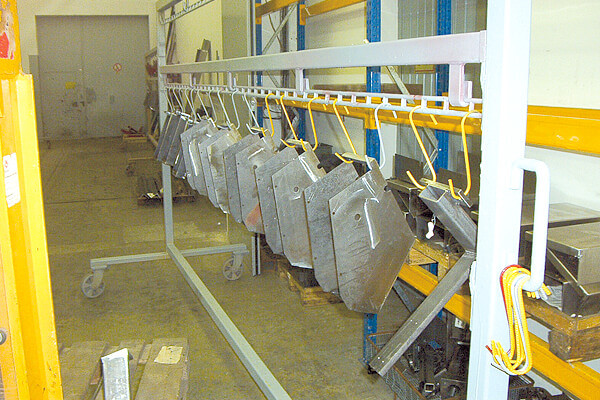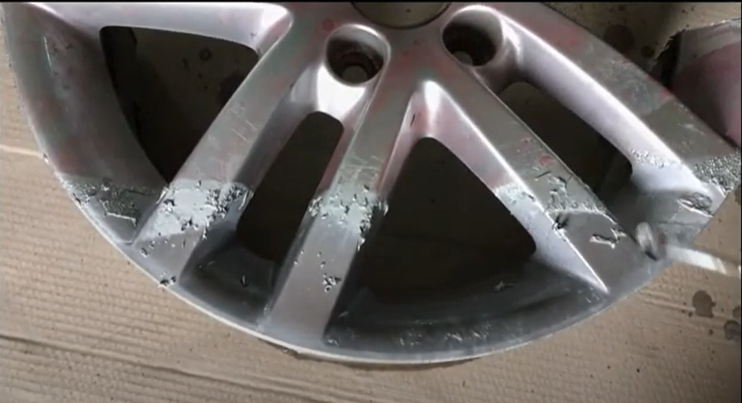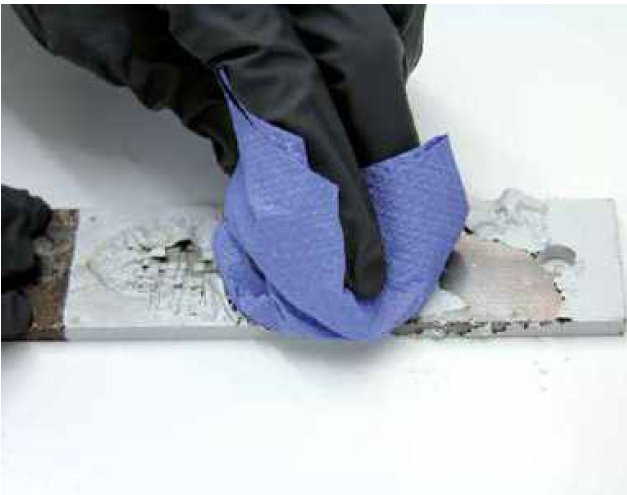Poor coating / poor paint adhesion~ What are the possible causes? Cleaning, rust removal, film!?
Painting/baking goes through several processes, where will the problem occur?
From process selection, surface cleaning, to film treatment, discuss them one by one!
1. Selection of treatment technology
Depending on different base materials, the treatment methods will also be different. For example, iron parts must be pre-treated with a phosphate film. If there is rust or paint residue, it must be removed beforehand. For aluminum materials, the oxide layer on the surface needs to be stripped off first to obtain the best coating effect. The galvanized layer on galvanized parts helps to increase the adhesion of painting/baking paint, but the workpiece needs to be baked before painting to remove moisture and air on the surface. According to the customer's needs, if it needs to be exposed to the sun for a long time, it is necessary to choose process conditions and materials that are resistant to ultraviolet rays and weather. If it needs to be placed at the beach for a long time, it is necessary to choose a treatment process that can withstand high salt corrosion. These judgments and choices will affect the adhesion performance of the final coating or baking paint.

▲Many industrial processes include coating processes, and the choice of process is crucial
2. Surface cleaning
When painting/baking the workpiece at the beginning, the dust, fine chips, dirt, and oil stains on the surface must first be removed and cleaned, even if If there is rust or the previous paint layer still remains on the surface, rust removal or paint removal must be carried out to ensure a high degree of cleanliness on the surface of the workpiece. Painting without complete cleaning can lead to problems with the paint layer and poor adhesion. The following is a list of several bad conditions and causes caused by poor cleaning procedures:
| Painting / Defects in baking paint | Possible reasons | Preventive measures |
|---|---|---|
| Premature coating failure | The surface of the workpiece is rusty and untreated | Remove the rust layer by sandblasting, grinding or chemical rust removal |
| Bubbles/holes | Water vapor and air remain on the surface of the workpiece | Bake the workpiece before painting at a temperature between 100-110 degrees |
| Fish Eye | Oil and wax on the surface of the workpiece | Perform a complete cleaning process for the substrate |
| Poor adhesion of paint layer | Poor cleaning in large areas, improper surface treatment | Choose the appropriate pre-treatment process, complete cleaning, sandblasting and polishing |
2.1 Rust removal
General rust removal methods can be carried out by physical and chemical methods. The physical method is more convenient to use sandblasting. The sandblasting materials used usually include steel sand, glass beads, etc. At the same time, if there is a separate sandblasting workshop, the sandblasting materials can be recycled and reused, which will help the economic feasibility of this process.
Chemical rust removal can remove the rust layer on the metal surface by soaking it in acidic or neutral rust remover. The acidic rust remover also has a degreasing function. After adjusting the appropriate concentration, it can treat steel and galvanized workpieces. After rust removal, the workpiece must be washed with plenty of water and dried. Depending on the subsequent treatment process, immediate passivation or phosphating may be necessary to avoid the formation of a new rust layer. If the rust layer is thick, it will need to be processed multiple times.
| Item | Sandblasted | Acid chemical rust removal | Neutral chemical removal Rust |
|---|---|---|---|
| Ingredients | Steel sand, glass beads | Phosphoric acid, sulfuric acid base | Phosphate base |
| Principle | Spray the sandblasting medium on the surface at high speed to create tiny depressions on the surface of the workpiece, which can be used to remove rust, oxide layers, burrs, and residual paint. | Use acid to react chemically with the surface layer of the workpiece, peeling off the rust layer, oxide layer and burrs in a large area. | Use phosphate to produce a mild chemical reaction with the surface layer of the workpiece, peeling off the rust layer, oxide layer and burrs in a large area. |
| How to use | Use a sandblasting machine to generate high-speed gas | Soak, configure 20-50% concentration, normal temperature | Soak, configure 3-10% concentration, heat 50-70°C |
| Applicable materials | Steel, iron, non-ferrous metals, ceramics, glass and other non-metals | Steel, iron, galvanized | Steel, iron, non-ferrous metals |
| Features | It is a physical rust removal, which can be applied to a variety of materials, and the sandblasting medium can be recycled | Effective for large areas or large batches handling | Effectively handles large-scale or large-volume workpieces |
| Danger level | Physical treatment, no chemical hazard level | Eight Class Acid Dangerous Goods | Neutral product, no chemical hazard level |
2.2 Paint removal/removal
If it is a heavy workpiece or a repaired part, sometimes the paint layer still remains on the surface, and even the entire surface of the intact paint layer needs to be removed first. Only then can the next process be progressed. Paint removal can also be divided into physical and chemical treatment methods. The physical method can use fire baking, which uses high temperature to soften the paint layer before further processing. The fire baking temperature must also be moderate to avoid affecting the substrate. In addition, sandblasting can also be used to allow the sandblasting medium to directly remove the paint layer and also treat the oxide layer.
The chemical method is mainly soaking in strong alkali or organic solvent. Strong alkali type paint removal mainly relies on the corrosiveness of alkali to destroy the paint layer. When using it, you should also pay attention to the corrosive effect on the workpiece. It is usually more suitable for use on stainless steel or iron parts. With the tightening of regulations on chlorinated solvents and NMP in European and American countries, environmental protection demands have gradually received attention. Following this, paint removers that are non-chloroform, non-NMP and comply with EU standards have emerged. Some of them are even suitable for sensitive products. Metal parts such as aluminum alloy or brass.
▲The residual paint layer must be completely removed to avoid affecting the painting
2.3 Cleaning
The cleaning here usually uses alkaline cleaning agents to remove obvious dirt, oil stains and dust on the surface of the pre-coated workpiece. Depending on the workpiece material and operation method, you can choose different cleaning agents such as strong alkaline, neutral, and low foam. Different types of cleaning products can be selected according to different on-site operation methods.
| Operation method | Soak | Spray |
|---|---|---|
| Representative products | CB 100 | UNO S F |
| Features | Water-based, phosphate- and solvent-free cleaner. Powerful dissolving power and consistently good cleaning performance. | Water-based, low-foaming cleaning power, especially suitable for mechanical or high-pressure cleaning. |
| Targeting pollutants | For removing strong contaminants such as difficult-to-remove specialty greases, rubber marks, asphalt and wax residues, oils and pastes | Can remove extremely heavy dirt, such as burnt oil, resinous grease, pigment ink, protein, etc. |
| Residual rate (RFU) | No data | 17 (1:10)* |
*Diluted 10 times the concentration
The cleaning process usually uses clean water at the end, and most factories use tap water for convenience. This causes chloride in the water to remain on the surface of the workpiece. There is a risk of subsequent rusting. Therefore, it is usually recommended to use deionized water or RO water as rinse water. After cleaning, you usually choose to dry or air-dry. However, because exposure to the atmospheric environment may cause rust, it is best to enter the next process as soon as possible after drying.
▲Insufficient cleaning is often the main cause of poor painting
3. Surface treatment
3.1 Transformation membrane
The phosphating process is to form an insoluble crystalline conversion layer on the surface of the workpiece. The purpose is to serve as a dielectric layer before the paint layer and the substrate, which helps to achieve good quality. It has good adhesion ability and also has short-term rust prevention ability. The key to this stage is the growth status of the phosphating crystal layer. When the residence time, temperature, accelerator concentration and other factors in the phosphating tank are inappropriate, they may affect the final coating result. Therefore, the weight of the phosphating layer Testing is a necessary quality management action. The use of iron phosphide usually has more economic advantages than zinc phosphide. Although the protection provided by zinc phosphide film is more durable, most of them are still based on iron phosphide system. The following table lists the characteristics and issues that need attention of the three types of membranes:
| Coat type | Iron phosphate | Zinc Phosphate | Zirconium based film |
|---|---|---|---|
| Crystal Form | Amorphous | Crystalline | Amorphous |
| Coat thickness | ~250nm | 1000-5000nm | ~50nm |
| Coating weight | 300-700 mg/m² | 2000-3000 mg/m² | 50-150 mg/m² |
| Features | Cheap and easy to operate. A large amount of iron sludge. Needs to be heated and added with accelerator. |
Need to add table tuner and accelerator. | Because it can be operated at room temperature, it consumes low energy. The waste treatment volume is small and there are no phosphate emission restrictions. |
| Question | Produces a large amount of sludge and phosphorus-containing wastewater, making waste treatment difficult. The heavier the film weight, the better. Exceeding the appropriate amount will form residues on the surface and reduce adhesion. |
Produces a large amount of sludge and phosphorus-containing wastewater, making waste treatment difficult. A water softener can be installed to reduce the sludge formed by calcium, magnesium ions and phosphates. Proper crystallization adjustment is required, otherwise the crystallization of the film will be quite sparse and the adhesion will be reduced. |
The tank liquid impurity control requirements are high, iron accumulation may occur, and a filter needs to be installed. Poor control may cause flash rust. It is necessary to adjust the pH to 6-6.5 or add a neutralizing agent before the zirconization film. |
3.2 Cleaning
If there is still some preparation before painting, the final step should be to remove any chemicals used to clean and prepare the surface. If the surface is not cleaned thoroughly, leftover residue can damage the powder coating. If parts are cleaned manually, acetone or environmentally friendly hydrocarbon solvents can be used after sandblasting the surface. For materials with poor chemical resistance, such as PC, ABS and other plastic materials, you can consider using water-based easy-drying products that do not damage plastics, have low VOC and low residue, such as FT 300 of the FT series, because they do not contain interface activity. The agent has the characteristics of extremely low residue after cleaning the plastic surface. If there is a strong need for cleaning residual grease, release agents, fingerprints, etc., you can consider low-residue cleaners that add surfactants, such as FT 200. The following is a comparison of two low-residue, easy-drying cleaners:
| Product | FT 200 | FT 300 |
|---|---|---|
| How to operate | Wipe, spray, soak | Wipe, spray, soak |
| Features | Water-based, ideal for surface preparation and final cleaning. Ideal for manual cleaning such as surface degreasing during manufacturing and processing. |
Water-based, surfactant-free cleaners are ideal for surface preparation and final cleaning. Degreasing prior to painting and labeling, as well as cleaning highly polished surfaces. |
| Applicable materials | Stainless steel, steel, tile, plastic and galvanized surfaces | Stainless steel, steel, ceramic tile, aluminum, non-ferrous metals, plastic and galvanized surfaces |
| Targeting pollutants | Removes moderate oil and grease stains, dust, fingerprints, wear debris, sanding dust, release agents and adhesive residues | Removes oil and grease contamination, dust, fingerprints, wear debris, sanding dust, release agent and adhesive residue |
| Residual rate (RFU) | 8 | 5 |

▲FT 300 can be used with a sprayer for the final cleaning
Summary
Painting/baking is one of the most effective and common surface anti-corrosion and beautiful methods at present, and can be widely used in various materials, such as glass and plastic , wood, iron, stainless steel and other metal materials. However, behind providing a beautiful coating, there are many processes and details that need to be carried out and paid attention to to ensure the perfect combination between the substrate and the coating, such as cleaning, rust removal, paint removal, conversion coating, etc. Step-by-step processing will have Helps achieve the desired finish level.
CONTACT US
Kelly Chemical Corporation
Electronics
TEL:(02)2762-1985 ext 11200
Online Message
Leave your contact information,
and we will get in touch with you soon.
Email Consultation
After receiving your email,
we will process it as soon as possible.send Email

